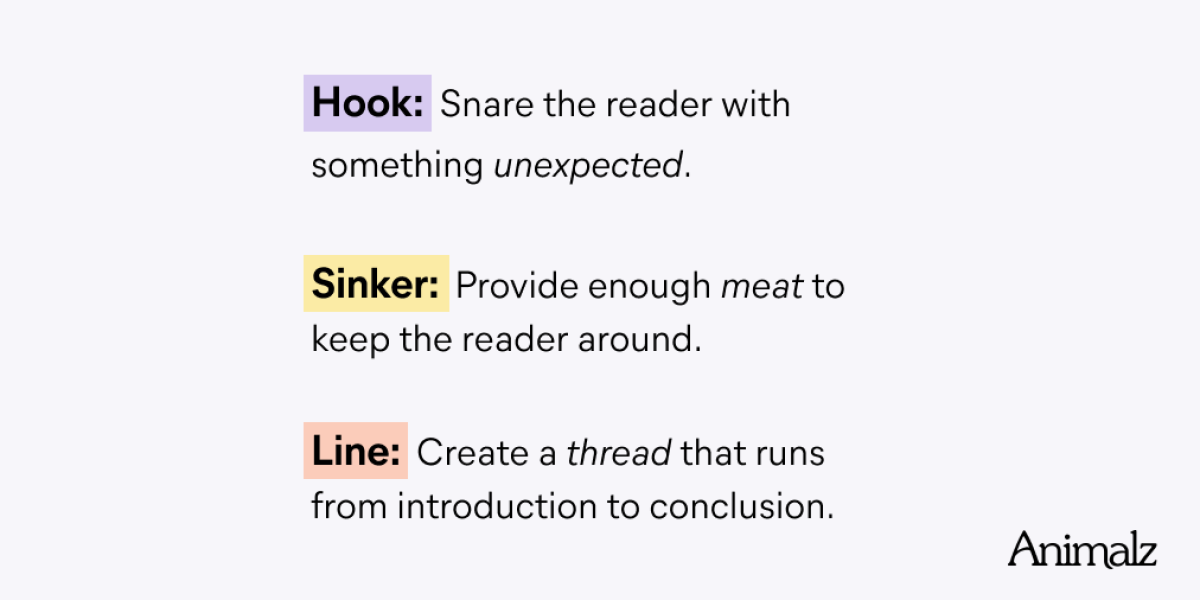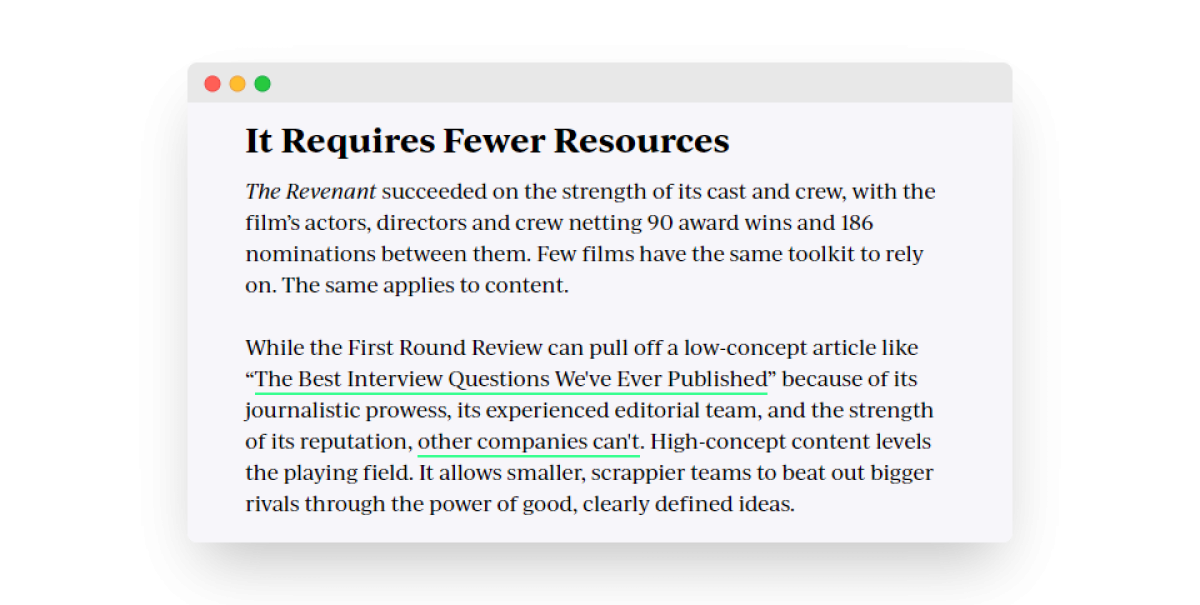The largest fish ever caught by rod and reel was a 2,664-pound great white shark. That’s over a ton of prehistoric saw-toothed terror, dangling from one end of an impossibly thin braided wire. At the other end was Alfred Dean, a hobbyist angler and professional fruit grower from Southern Australia.Aside from a few modifications to Alf’s get-up — like a “fighting chair” and bait made from slabs of porpoise meat — an amateur angler would recognize the equipment he used: steel hook, weighted sinker, fishing line. The hook snares the fish, the sinker pulls the hook deep enough for the fish to find the bait, and (at the risk of stating the very obvious) the line keeps the fish connected to the fisherman.While Mr. Dean can teach us plenty about shark fishing, writers can use a similar technique to completely and totally engage their audience. You could say readers fall for it hook, line and sinker.

Hook: Use Pattern Interrupts to Pique Interest
Fishing hooks come in all shapes and sizes, from salmon egg bait hooks to swimming nymph fly lures. Some are designed to mimic insects, while others hold big pieces of bait. Despite noticeable variations, they serve the same core purpose: to hook a fish.Writing hooks are much the same, coming in all shapes and sizes, but each serving a primary purpose: subvert a reader’s expectation to snag their attention.The “art” of writing a good hook is often made out to be more complicated than shark fishing. But the best hooks simply look and feel different from what the reader expects. If you still think that surprising the reader sounds tricky, consider this: Most articles begin with predictable, boring opening lines:
“The average employee spends too many hours a week doing something tedious, costing companies billions annually. Imagine if your staff could get that time back …”
“A Harvard University study found that eight out of 10 professionals …”
“Webster’s Dictionary defines ‘intro’ as the beginning, sometimes used to capture attention. In this article …”
“Did you know that most marketers …”
Hooks do the opposite: They are unexpected. They break with convention and force the reader to pay attention. One example we use during our onboarding process for new writers comes from the article High-Concept Content: the Hollywood Framework for Crafting Popular Content:

The article about content marketing opens with two short paragraphs comparing B-movie extraordinaire Snakes on a Plane with the Oscar-winning The Revenant. It’s hard for the reader to gloss over this introduction because it’s so unexpected (and well-written, not belabored). Whether they like it or not, their attention has been hooked.
How to Write a Hook
There are dozens of ways to pique reader interest, all equally valid, but a few formats are particularly effective:
Metaphor. Figures of speech serve dual purposes: They make unfamiliar topics easier to understand, and they allow the writer to pull stories and ideas from interesting places. Take this ProfitWell article using the Greek legend of Icarus to draw parallels with customer churn.
Non sequitur. Our own head of R&D, Andrew Tate, introduces the reader to the GPT-3 AI model through berserk llama syndrome, Seinfeld, and Shakespeare. Random concepts? Hardly. The reader quickly learns that each is a part of GPT-3’s dataset.
Hypothetical. Make the reader an active participant in your writing by using a relatable hypothetical situation, like this example from WorkOS. Turns out, driving through San Francisco in 2016 is tangentially related to developer-led business models (and surprising to someone who needs to read about them).
Quote. Introduce third-party expertise and context by pulling a quote from literature, fiction, or history. UiPath plays with Archimedes’ wisdom to frame the idea of “leverage” in enterprise businesses.
Anecdote. Create a human connection by sharing a personal experience (or someone else’s personal experience), like Wildbit sharing their first-person perspective on hiring. It also contextualizes the idea of “people-first” recruitment practices.
Data. Let numbers speak louder than words. See how Appcues uses Slack’s revenue figures to hint at the outsized impact product adoption has on a company’s bottom line.
Just like fish populations can gradually acclimatize to lures, readers become accustomed to the same hooks. When every writer defaults to inspirational quotes and generic statistics, for instance, they become the next pattern that needs interrupting.
Sinker: Provide Substance with a Clear Thesis
Most fishing lines are light enough that they’ll float on the surface of the water. In order to catch fish, the line needs a small weight attached to it so that it sinks deep enough for the fish. The same principle applies to content. A catchy hook is often enough to pique a reader’s interest, but when introductions don’t offer substance — without meat! — readers won’t stick around. (There’s a name for this type of content: clickbait.)Introductions need to pique the reader’s interest and deliver on the expectation created by that hook. Most would-be readers click-through to an article from an email, social post, or a search results page. Those first few sentences set a particular expectation — that they’ll learn something concrete or experience a compelling story. The introduction must prove to the reader that their expectations will be met.Do this with a thesis — a clear, concise summary of the argument you’re making. As we explained in our article about outlining, “The idea expressed in your thesis is your destination — by the end of the draft, you will have convinced your readers of something. What is that something?”Our Snakes on a Plane article has an interesting hook, but it also delivers on the expectation set by the title: The reader will learn how to craft popular content. It starts to deliver on that expectation by sharing a clear thesis statement, right there in the introduction:
“Some content is high-concept: The reader can immediately anticipate what the article is about and what the value is. Some content is low-concept: The value of the article isn’t immediately apparent, and it relies on great execution to make it satisfying.”

As well as sharing a clear thesis, great introductions provide depth by:
Demonstrating relevance to the reader. Every article is written with a target audience in mind, and great introductions reassure the reader that yes, this is written for you — like this I Done This article, clearly written for the leaders of development teams, or this brightwheel piece, obviously intended for managers of childcare centers.
Highlighting concrete benefits from reading. Be explicit about the tangible benefits your article offers for prospective readers, like this Animalz article that introduces the possibility of helping your articles “generate hundreds of backlinks and rack up hundreds of thousands of views.”
Hooks perform the flashy job of getting attention, but the burden of holding attention falls to the thesis portion of your introduction. The thesis is your sinker.
Line: Connect Your Introduction to the Rest of the Article
Modern fishing lines are exceptionally tough, able to endure strains into the thousands of pounds, all while resisting abrasion from teeth and corrosion from the elements. They keep every component of the fishing experience connected to every other, from the rod and hook to the angler and the fish. In a similar vein, great introductions establish a connective thread that runs throughout the entire article.Many good writers think of hooks as standalone tools. They expend a huge amount of mental energy to share interesting, unexpected ideas in their first few paragraphs … and then forget all about the metaphors, anecdotes, and data points they’ve introduced. The introduction is catchy, but it has little bearing on the rest of the article. It may even feel disjointed or superficial.Great introductions carry the unexpected throughout the rest of the article. It’s revisited in order to add greater clarity to each of your points. It builds a single unifying framework that structures the entire piece. To make the point, here’s our example article from before:

The hook from the introduction is revisited later in the article and used to introduce and contextualize a key point. This process is repeated throughout the article:

The result is a continuous narrative, spanning from introduction to conclusion. The metaphor hooks the reader, but it also improves comprehension of the entire article.Here’s another example from estate planning platform Vanilla. On its own, a hook about ghost stories risks feeling cheap and sensationalist, bearing little connection to the meat of the article — real estate planning. But by revisiting the hook throughout the article, working it into headers and body copy, the metaphor creates a helpful and satisfying narrative thread.This thread separates good introductions from great ones. It isn’t always easy (like writing an article about introductions using dozens of fishing metaphors), but the result is more memorable, more cohesive, and more useful to the reader when done well.
Land the Big One
Many writers spend more time wrestling with introductions than shark anglers wrestling great whites, and for good reason: They’re hard. Introductions must pique a reader’s interest, introducing the article’s thesis, and compel the reader to keep reading. They must carry a huge amount of tension, balancing intrigue with relevance, novelty with familiarity.So, here’s a process to try: Sit in your “fighting chair” and clearly define your thesis. That’s your generic but functional intro. Now, look for a metaphor that helps you explain it, something that loosely connects back to each of your key points. Finally, use an anecdote, data point, or story to illustrate your metaphor. Combine and hit publish.Note: Gail Marie is an almost-vegan and does not condone sport fishing. Still, the metaphor stands. Or swims.
